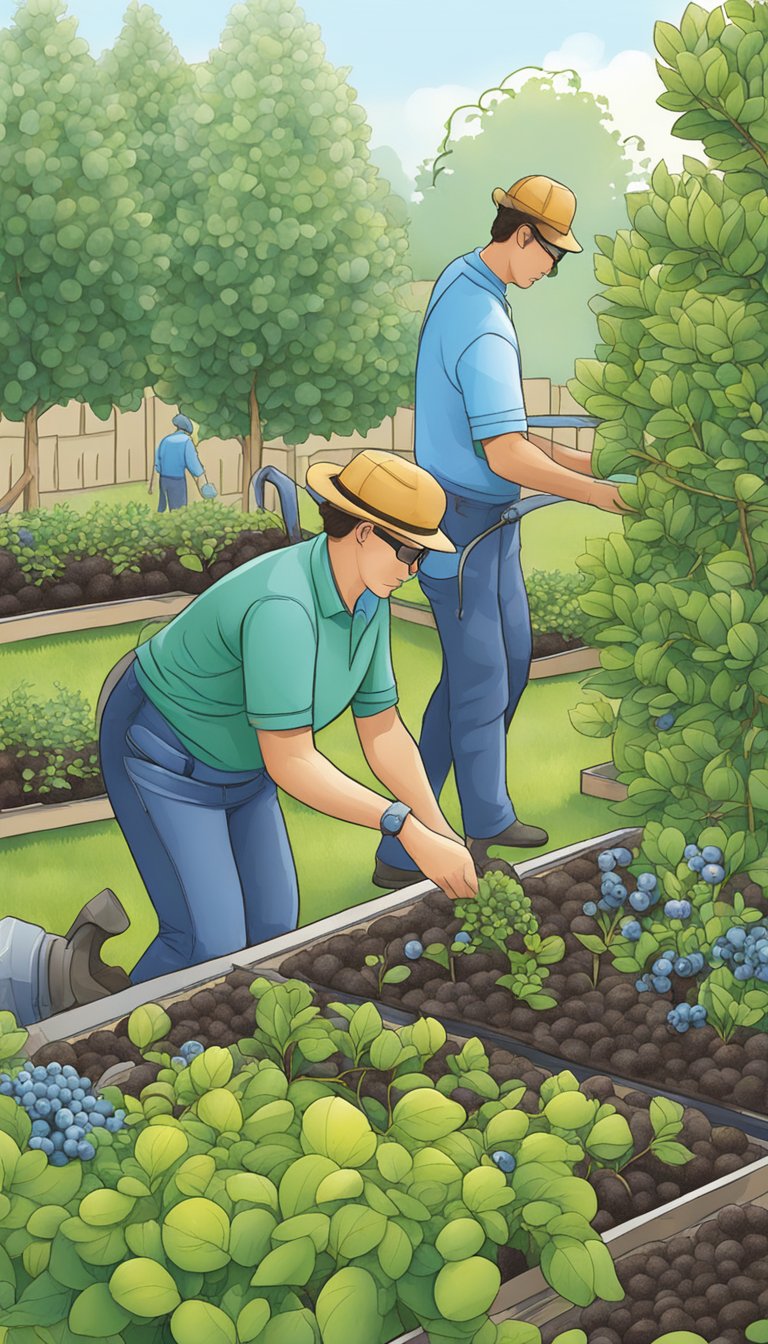If you’re a blueberry lover and have decided to plant blueberry bushes in your backyard, you may be wondering how many bushes you should plant.
This post may contain affiliate links.
The answer to this question depends on a few factors, including the size of your yard, the amount of sunlight the area receives, and your personal preferences.
First consider the size of your yard and how much space you have available for blueberry bushes. Blueberry bushes can grow up to 6 feet tall and 4 feet wide, so you’ll need to ensure that you have enough space for each bush to grow and thrive.
A good rule of thumb is to plant blueberry bushes at least 4-6 feet apart to allow for adequate air circulation and sunlight.
Next, think about the amount of sunlight the area receives. Blueberry bushes require full sun to produce the best fruit, so choose a spot in your yard that receives at least 6-8 hours of direct sunlight each day.
If you have a shady yard, you may need to consider planting fewer bushes or choosing a different fruit to grow.
Determining Your Blueberry Needs
Blueberry bushes are a great addition to any garden, but before you start planting, it’s important to determine how many bushes you’ll need. Here are some things to consider:
Assessing Your Space
Take a look at your garden and determine how much space you have available for blueberry bushes. Blueberry bushes can grow quite large, so you’ll need to make sure you have enough room for them to spread out.
You should also consider the amount of sunlight your garden receives. Blueberry bushes thrive in full sun, so make sure your garden gets at least six hours of direct sunlight per day.
Calculating Plant Numbers
Once you’ve assessed your space, you can start calculating how many blueberry bushes to plant. A good rule of thumb is to plant one bush per person in your household. So if you have a family of four, you’ll need four blueberry bushes.
You should also consider the size of the blueberry bushes you plan to purchase. Some varieties grow larger than others, so make sure you choose a variety that will fit comfortably in your garden.
Finally, keep in mind that blueberry bushes need to be planted in pairs to ensure proper pollination. So if you’re planting four bushes, you’ll need to purchase two different varieties to ensure cross-pollination.
Choosing the Right Varieties

When it comes to planting blueberry bushes, choosing the right varieties is crucial for a successful harvest. There are several factors to consider when selecting blueberry types, including your climate, berry size, and flavor preferences.
Understanding Blueberry Types
There are several types of blueberries to choose from, including highbush, rabbiteye, southern highbush, northern highbush, lowbush, and half-high. Highbush blueberries are the most common and widely cultivated type, while rabbiteye blueberries are popular in the southern United States.
Southern highbush blueberries are a hybrid of highbush and rabbiteye, and northern highbush blueberries are best suited for cooler climates.
Lowbush blueberries are native to northeastern North America and are typically smaller in size, while half-high blueberries are a cross between highbush and lowbush varieties. If you live in a hot, humid climate, rabbiteye blueberries may be a better choice.
Considering Berry Size and Flavor
Blueberries come in a variety of sizes and flavors, so it’s important to choose varieties that meet your preferences. Some varieties produce larger berries, while others produce smaller, more delicate berries.
Additionally, some varieties have a sweeter flavor, while others have a more tart taste. If you prefer larger berries, consider planting highbush or rabbiteye varieties. If you prefer sweeter berries, southern highbush varieties may be a good choice.
Site Preparation and Soil Conditions
Before planting blueberry bushes, it’s important to prepare the site and ensure that the soil conditions are suitable for their growth. Here are some key factors to consider:
Testing and Adjusting Soil pH
Blueberries prefer acidic soil with a pH between 4.0 and 5.5. You can test your soil’s pH using an inexpensive soil testing kit or by sending a sample to a lab for analysis.
If your soil is too alkaline, you can lower the pH by adding sulfur or other acidifying agents. It’s important to adjust the pH well in advance of planting, as it can take several months for the soil to become acidic enough for blueberries.
Improving Soil Quality
Blueberries thrive in well-drained soil that is rich in organic matter. If your soil is heavy clay or poorly drained, you may need to amend it with organic matter such as compost or peat moss. This will help improve the soil’s texture and drainage, as well as provide nutrients for the plants.

Selecting the Best Location
Blueberries require full sun to produce the best fruit, so it’s important to choose a location that receives at least 6-8 hours of direct sunlight per day.
They also prefer a slightly sloping site that allows for good drainage. Avoid planting blueberries in low-lying areas or areas with standing water, as this can lead to root rot.
Planting Guidelines
If you’re wondering how many blueberry bushes you should plant, there are a few things to consider. Here are some planting guidelines to help you get started.
Best Time to Plant
The best time to plant blueberry bushes is in early spring or late winter, while the plants are still dormant. This gives them time to establish their roots before the growing season begins.
If you’re planting bare-root bushes, make sure to do so as soon as possible after you receive them.
Planting Techniques
When planting blueberry bushes, make sure to dig a hole that is twice as wide and deep as the root ball. Gently loosen the roots and place the plant in the hole, making sure that the top of the root ball is level with the soil surface. Backfill the hole with soil and water thoroughly.
Spacing and Arrangement
Blueberry bushes should be spaced 4-6 feet apart in rows that are 8-10 feet apart. This allows for good air circulation and makes it easier to harvest the berries. If you’re planting multiple rows, make sure to leave enough space between them for equipment and maintenance.
Caring for Blueberry Bushes
Blueberry bushes are relatively easy to care for, but they do require some attention to ensure they grow and produce healthy berries. Here are some tips on how to care for your blueberry bushes.
Watering and Moisture Management
Blueberry bushes require consistent moisture to thrive. Make sure to water your blueberry bushes regularly, especially during hot and dry weather.
A good rule of thumb is to water your blueberry bushes deeply once a week, providing about 1 inch of water. However, be careful not to overwater your plants, as this can lead to root rot.
In addition to regular watering, it’s important to manage the moisture levels around your blueberry bushes. Blueberry bushes prefer moist soil, but not soggy soil.
To help maintain moisture levels and prevent weeds from growing, apply a layer of mulch around the base of your blueberry bushes.
Mulching and Fertilization
Mulching is an important part of caring for your blueberry bushes. A layer of organic mulch, such as wood chips or pine needles, helps to retain moisture, suppress weeds, and regulate soil temperature.
Apply a 2- to 4-inch layer of mulch around the base of your blueberry bushes, being careful not to cover the crown of the plant.
Fertilizing your blueberry bushes is also important for their health and productivity. Blueberry bushes require acidic soil with a pH between 4.5 and 5.5. I
f your soil is not naturally acidic, you may need to add an acidic fertilizer, such as ammonium sulfate or sulfur. Apply fertilizer in the spring before new growth appears, following the instructions on the package.
Pruning for Health and Productivity
Pruning is another important aspect of caring for your blueberry bushes. It helps to maintain the shape of your bushes, remove dead or diseased wood, and promote new growth and fruit production.
Prune your blueberry bushes in late winter or early spring, before new growth begins. Remove any dead or diseased wood, as well as any branches that are crossing or rubbing against each other.
Thin out the center of the bush to improve air circulation and sunlight penetration. Finally, prune back the tips of the remaining branches to encourage new growth and fruit production.
Protecting Your Blueberries
When it comes to growing blueberries, protecting your crop from pests and diseases is essential. Here are some tips to help you keep your blueberries healthy and free from harm.
Dealing with Pests and Diseases
Pests and diseases can quickly damage your blueberry bushes if left unchecked. Here are some common pests and diseases to watch out for and how to deal with them:
- Aphids: These small, soft-bodied insects can suck the sap from your blueberry bushes and cause leaves to curl and yellow. To control aphids, spray your bushes with a strong jet of water or apply insecticidal soap.
- Fruitworms: These pests can cause damage to the fruit and foliage of your blueberry bushes. To control fruitworms, use insecticides or handpick the worms off your bushes.
- Mummy berry: This fungal disease can cause the berries to shrivel up and turn brown. To prevent mummy berry, remove any infected berries from your bushes and apply fungicides as needed.
Bird and Wildlife Prevention
Birds and other wildlife can also pose a threat to your blueberry crop. Here are some ways to prevent them from eating your berries:
- Netting: Cover your blueberry bushes with bird netting to prevent birds from accessing your crop. Be sure to secure the netting to the ground to prevent animals from crawling underneath.
- Scare tactics: Hang reflective tape or old CDs from your blueberry bushes to scare birds away. You can also use scarecrows or fake predators to deter wildlife.
- Fencing: Install a fence around your blueberry bushes to keep larger animals like deer and rabbits from accessing your crop.
Additional Tips for Blueberry Growers
Understanding Pollination
Pollination is a crucial factor in the growth of blueberry bushes. Blueberries are self-fertile, which means that they can produce fruit without cross-pollination from another bush. However, cross-pollination can lead to larger yields and better fruit quality.
To ensure cross-pollination, it is recommended to plant at least two different blueberry varieties that bloom at the same time. Bees are the primary pollinators of blueberries, so it is important to provide a habitat for them in your garden.
You can do this by planting flowers that attract bees or by providing a bee house.
Frequently Asked Questions
What’s the ideal spacing for planting blueberry bushes in my garden?
The ideal spacing for planting blueberry bushes in your garden is approximately 4-5 feet apart. This spacing allows the bushes to have enough room to grow and spread out while also providing adequate air circulation to prevent disease.
Can you tell me how many blueberry bushes are needed to adequately supply a family of four?
On average, a family of four will need about 6-8 blueberry bushes to adequately supply their needs. However, this number may vary depending on the size of the bushes and the amount of fruit each produces.
What are some good companion plants for blueberry bushes?
Some good companion plants for blueberry bushes include azaleas, rhododendrons, and ferns. These plants provide shade and help to maintain the acidic soil conditions that blueberry bushes require.
Is it necessary to have more than one blueberry bush to ensure pollination and fruit production?
Yes, it is necessary to have more than one blueberry bush to ensure proper pollination and fruit production. Blueberry bushes are not self-pollinating, so you will need to have at least two different varieties of blueberry bushes to ensure cross-pollination.
What type of environment do blueberry bushes thrive in for the best yield?
Blueberry bushes thrive in acidic soil with a pH range of 4.0-5.5. They also require full sun exposure and consistent moisture. Proper pruning and fertilization can also help to increase yield.
Could you provide guidance on the proper depth for planting blueberry bushes?
When planting blueberry bushes, it’s important to ensure that the root ball is at the same level as the soil surface. The hole should be deep enough to accommodate the root ball, but not so deep that the base of the stem is buried.
It’s also important to ensure that the soil is well-drained to prevent waterlogging.
Follow my gardening board on Pinterest.




